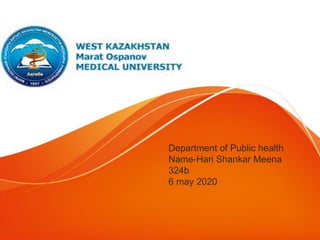
medical audit in hospital
- 1. Department of Public health Name-Hari Shankar Meena 324b 6 may 2020
- 2. • Medical audit is the systematic, critical analysis of. the quality of medical care, including the procedures. used for diagnosis and treatment, the use ofresources, and the resulting outcome andquality of life for the. patient'.
- 3. • Audit can be used to evaluate various aspects of patient care: • Structure of care - eg, the availability of a smoking cessation clinic in a locality. • Process of care - eg, waiting times for an appointment at the smoking cessation clinic. • The outcome of care - eg, the number of smokers who quit smoking for one year.
- 4. • Audit should be transparent and non- judgemental. The aim is to find out how the present provision compares with the desired standard. This information can then be used to plan improvements in the service. It is not intended to cause confrontation or blame.
- 5. • The General Medical Council (GMC) states that, as part of good medical practice, maintaining and improving performance, doctors are required to[2]: • Take part in regular and systematic audit. • Take part in systems of quality assurance and quality improvement. • Respond constructively to the outcome of audit, appraisals and performance reviews, undertaking further training where necessary.
- 6. • Audits should be full cycle - ie initial audit, change implemented, re-audit to demonstrate improvement. • There should be at least one complete audit in each five-year revalidation cycle. • Audits may be undertaken by several GPs working as a team. However, you must have been involved in all key parts of the audit, and explicitly state how you were involved.
- 7. • Key points to audit for GPs are: • Relevance of the topic chosen. • Appropriateness of the standards of patient care set. • Reflection on current care and the appropriateness of changes planned. • Implementation of change for the GP's patients. • Demonstration of change by the GP.
- 8. • Dates of first and second sets of data collection. • Criteria to be audited and standards set with justification, or clinical condition to be audited, or process of care to be audited (all with reference to evidence-based guidelines). • Results of the first data collection and comparison to standards which have been set. • Summary of subsequent discussion, and plan of change agreed. • Changes implemented.
- 9. Stage 1 - preparation • Choose a topic: • Preferably one which is a high priority for your organisation. • This may involve areas in which there is a high volume of work, high risks or high costs of care, or an area identified as a priority by patients.
- 10. • Identify available resources - eg: • Your organisation may have a local audit lead or office. • There may be existing guidelines defining desired standards for the topic you have chosen.
- 11. • Stage 2 - select criteria • Define the criteria. This should be in the form of a statement - eg: 'All patients with hypertension who smoke should be offered smoking cessation advice.' • Define the standard - usually a target (percentage). This may be a minimum standard or an optimal one, depending on the clinical scenario.
- 12. • Stage 3 - measuring level of performance • Collect the data: • May be from computerised records, manual collection, or both. • May be retrospective or prospective. • Analyse the data collected: • Compare actual performance with the set standard. • Discuss how well the standards were met. • If the standards were not met, note the reasons for this (if known).
- 13. • Stage 4 - making improvements • Present the results and discuss them with the relevant teams in your organisation. • The results should be used to develop an action plan, specifying what needs to be done, how it will be done, who is going to do it and by when.
- 14. • Stage 5 - maintaining improvements • This follows up the previous stages of the audit, to determine whether the actions taken have been effective, or whether further improvements are needed. • It involves repeating the audit (ie targets, results, discussion); hence the terms 'audit cycle' or 'audit spiral'.
- 15. • Identify which data need to be collected, how and in what form, and who is going to collect them. • Only collect information that is absolutely essential
- 16. •thanks